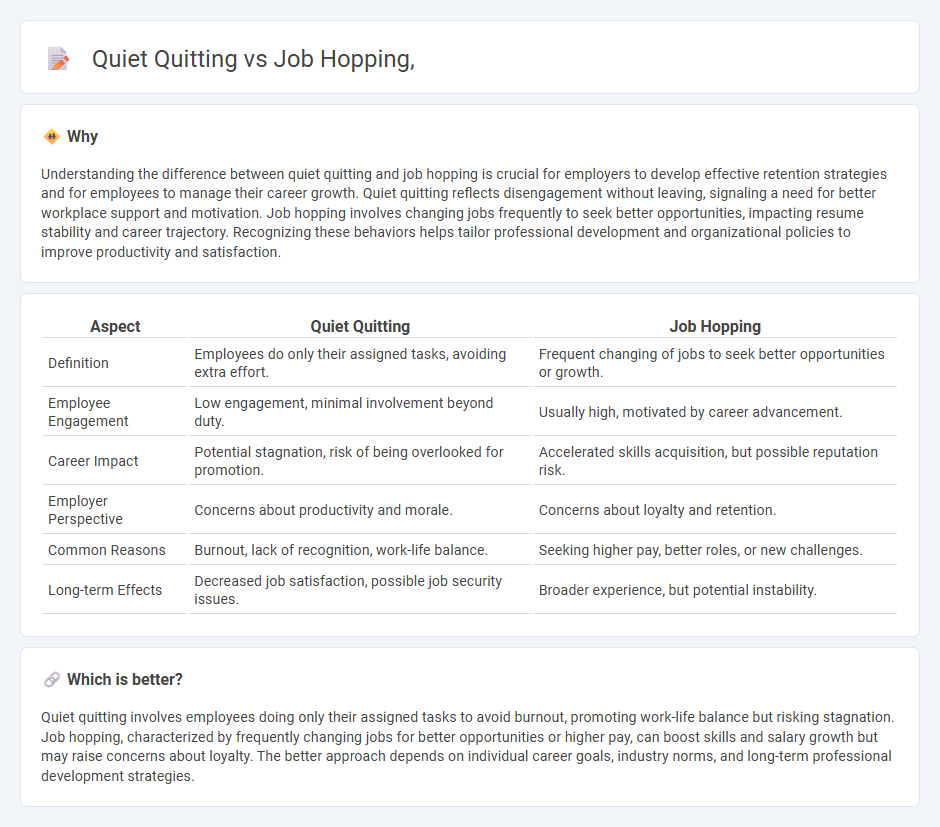
Quiet quitting involves employees limiting their work effort to job descriptions without extra engagement, while job hopping refers to frequent changing of jobs for better opportunities or satisfaction. Both trends impact workforce stability and organizational productivity, influencing recruitment and retention strategies. Explore the implications of quiet quitting and job hopping on modern employment dynamics.
Why it is important
Understanding the difference between quiet quitting and job hopping is crucial for employers to develop effective retention strategies and for employees to manage their career growth. Quiet quitting reflects disengagement without leaving, signaling a need for better workplace support and motivation. Job hopping involves changing jobs frequently to seek better opportunities, impacting resume stability and career trajectory. Recognizing these behaviors helps tailor professional development and organizational policies to improve productivity and satisfaction.
Comparison Table
| Aspect | Quiet Quitting | Job Hopping |
|---|---|---|
| Definition | Employees do only their assigned tasks, avoiding extra effort. | Frequent changing of jobs to seek better opportunities or growth. |
| Employee Engagement | Low engagement, minimal involvement beyond duty. | Usually high, motivated by career advancement. |
| Career Impact | Potential stagnation, risk of being overlooked for promotion. | Accelerated skills acquisition, but possible reputation risk. |
| Employer Perspective | Concerns about productivity and morale. | Concerns about loyalty and retention. |
| Common Reasons | Burnout, lack of recognition, work-life balance. | Seeking higher pay, better roles, or new challenges. |
| Long-term Effects | Decreased job satisfaction, possible job security issues. | Broader experience, but potential instability. |
Which is better?
Quiet quitting involves employees doing only their assigned tasks to avoid burnout, promoting work-life balance but risking stagnation. Job hopping, characterized by frequently changing jobs for better opportunities or higher pay, can boost skills and salary growth but may raise concerns about loyalty. The better approach depends on individual career goals, industry norms, and long-term professional development strategies.
Connection
Quiet quitting often leads employees to disengage without leaving their jobs, yet persistent dissatisfaction drives many towards job hopping as a means to seek better opportunities and work environments. Both behaviors reflect underlying issues such as burnout, lack of career growth, and inadequate recognition, signaling a disconnect between employee expectations and corporate culture. Organizations monitoring these trends must address workplace well-being and development initiatives to reduce turnover and enhance employee commitment.
Key Terms
Retention
Job hopping, characterized by frequent changes in employment, impacts retention by increasing turnover costs and disrupting team cohesion. Quiet quitting, where employees disengage without leaving, reduces productivity and hampers organizational growth. Explore effective retention strategies to address both phenomena and strengthen your workforce.
Engagement
Job hopping often signals a search for better opportunities and higher engagement, reflecting an active approach to career growth and fulfillment. Quiet quitting indicates disengagement, where employees meet minimum requirements without extra effort, highlighting a disconnect from workplace motivation and satisfaction. Explore how understanding these behaviors can enhance employee engagement and retention strategies.
Burnout
Job hopping often stems from burnout as employees seek immediate relief and new opportunities to escape stressful work environments. Quiet quitting reflects a more passive response where individuals mentally disengage and reduce effort to preserve mental health without leaving. Explore the nuanced relationship between burnout, job hopping, and quiet quitting for deeper insights into employee well-being.
Source and External Links
What Is Job Hopping? (Plus Advantages and Disadvantages) - Job hopping means frequently changing jobs within a short time and has become more common today as a strategy to seek higher pay, better titles, or new challenges, though employers still want to see good reasons for each move and traits like dependability.
Job-Hopping With Intention: Pros, Cons, and Considerations - Job hopping involves staying at a job about one to two years and is often done to find better career paths, avoid boredom, learn new skills, or find a better cultural fit, although some employers may still view it unfavorably.
Job Hopping | What is it and what are its advantages? - Job hopping is an increasingly popular trend where professionals, especially younger and digitally skilled workers, frequently change jobs voluntarily to seek new challenges and career growth, and many companies are starting to value this positively.
 dowidth.com
dowidth.com